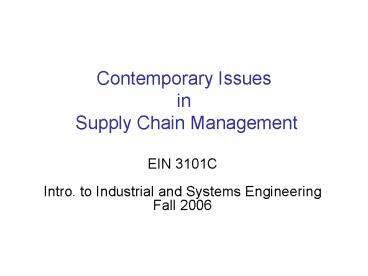Contemporary Issues in Supply Chain Management PowerPoint PPT Presentation
1 / 30
Title: Contemporary Issues in Supply Chain Management
1
Contemporary Issues in Supply Chain Management
- EIN 3101CIntro. to Industrial and Systems
EngineeringFall 2006
2
Outline
- Introduction
- Inventory Control
- Bullwhip Effect
- Possible Solutions
3
Supply Chains
- To be competitive, companies must shorten the
time it takes to design, produce, and ship their
products. (B. Bacheldor, Steady Supply,
Informaticweek, November 24, 2003.)
4
Supply Chains
- Mattel can meet demand because it spent the last
few years paying a lot of attention to simplify
its supply chain, cut cost, shorten cycle times,
and bring more science to the art of meeting
customer demand. (B. Bacheldor, Steady Supply,
Informaticweek, November 24, 2003.) - Mattel also has installed optimization software
that helps it measure, tweak, and validate ...
the locations of its seven distribution centers,
7 manufacturing plants, and other facilities
(B. Bacheldor, Steady Supply, Informaticweek,
November 24, 2003.)
5
Inventories
- An important component in a supply chain is its
inventories of, e.g., finished goods, raw
materials, and work in progress. - Q Why do we need inventories?
- To take advantage of economies of scale in
production and procurement. - To avoid the costs associated with fluctuating or
seasonal demands or requirements - To guard against uncertainties
- To gain flexibility in, e.g., production
scheduling - To take advantage of cost and price speculation
6
Managing Inventories
- What are the decisions in managing inventories?
- What?
- What items to inventory?
- Where?
- Where to keep the items?
- Where to order or from which supplier to order?
- When?
- When to place order?
- When to check the stock?
- How large or how many items?
7
Costs
- Is there any cost associated with having an
inventory? - Placing an order
- Space
- Equipments
- Labor
- Interests from banks or other financial
institutions - Opportunity cost
- Backorder (?)
8
Example
- A Gainesville convenient store sells 12 oz.
bottles of Gatorade. As a manager, how do make
sure that you always have Gatorade to sell to
your customers? - How often do you check your inventory?
- Continuously or periodically (e.g., at the end of
each day or week)? - Is continuous review possible?
- How do you decide whether to place an order?
- How much to order?
9
Basic Inventory Control Policies
- Focus on Periodic Review Policies
- Review period every hour, every day, every week.
- Two policies
- Order up to a target level or (s,S) policy
- Order when the inventory level lt s
- Amount to order (S current inventory level)
- (s,S) (10, 100)
- Order a fixed quantity or (s,Q) policy
- Order when the inventory level lt s
- Amount to order Q
- (s,Q) (10, 100)
10
(s, S)-Policy
- Convenient Store Examples
- Review period 5 days
- s 60 bottles of Gatorade
- S 300 bottles
- Delivery lead time 2 days
- No backorder
11
(s,S) (60, 300) Review Inventory every 5 days
12
(s,S) (60, 300) with Review Period 5 days
13
(s, Q)-Policy
- Convenient Store Examples
- Review period 5 days
- s 60 bottles of Gatorade
- Q 250 bottles
- Delivery lead time 2 days
- No backorder
14
(s,Q) (60, 250) review inventory every 5 days
15
(s,Q) (60, 250)
16
Optimal Policies
- In general, what are the values of s S or s Q
that we should use for managing our inventory? - Choose the values that yield the least cost.
- Depend on the daily demands
- For optimal solutions, see
- EIN 4401 and 4343
17
Intuition
- Consider the problem of determining the optimal
values of s and S. Which of the following is
harder and why? - Customer demands vary in a random manner.
- Customer demands are the same every day, e.g., 25
bottles of Gatorade every day.
18
Random Demand
19
Constant Demand (25/day)
20
Supply Chain Structure
- Supply chains typically consist of the following
players - Retailers
- Wholesalers
- Distributors
- Manufacturers
- Each player typically makes decision
independently or in a decentralized manner.
21
Demands in Supply Chains
- Retailers respond to customer demands.
- Orders placed by retailers become demands for
wholesalers. - Order placed by wholesalers become demands for
distributors - Order placed by distributors become demands for
manufacturers. - Manufacturers must produce items to meet these
demands.
22
Bullwhip Effect in Supply Chains
- Example 3 retailers with the same wholesaler
- Periodic (s, S) policy.
- Review Period 1 day
- Demand at Retailer 1 10/day (constant)
- Demand at Retailer 2 25/day (constant)
- Demand at Retailer 3 15/day (constant)
23
Bullwhip Effect in Supply Chains (Constant
demands)
24
Bullwhip Effect in Supply Chains(Constant
demands)
25
Bullwhip Effect in Supply Chains(Random demands)
26
Problems with the Bullwhip Effect
- What effects does the demand pattern with
exaggerated fluctuations have on the wholesalers,
distributors, and manufacturers? - Hold larger inventories to guard against
shortfalls - Larger fleet of delivery trucks
- Larger labor force or more overtime
27
Solutions
- Centralized planning (H.L. Lee, V. Padmanabhan,
and S. Whang, The Bullwhip Effect in Supply
Chains, Sloan Management Review, Spring, 1997,
pp. 93 102.) - Manufacturers and Retailers must become more
collaborative. (B. Bacheldor, Steady Supply,
Informationweek, November 24, 2003, pp. 35 - 40.)
28
Useful Technology
29
- Show the picture of a grocery store.
30
References
- B. Bacheldor, Steady Supply, Informationweek,
November 24, 2003, pp. 35 - 40. - H.L. Lee, V. Padmanabhan, and S. Whang, The
Bullwhip Effect in Supply Chains, Sloan
Management Review, Spring, 1997, pp. 93 102. - L.A. Johnson and D.C. Montgomery, Operations
Research in Production Planning, Scheduling and
Inventory Control, John Wiley, 1974.

